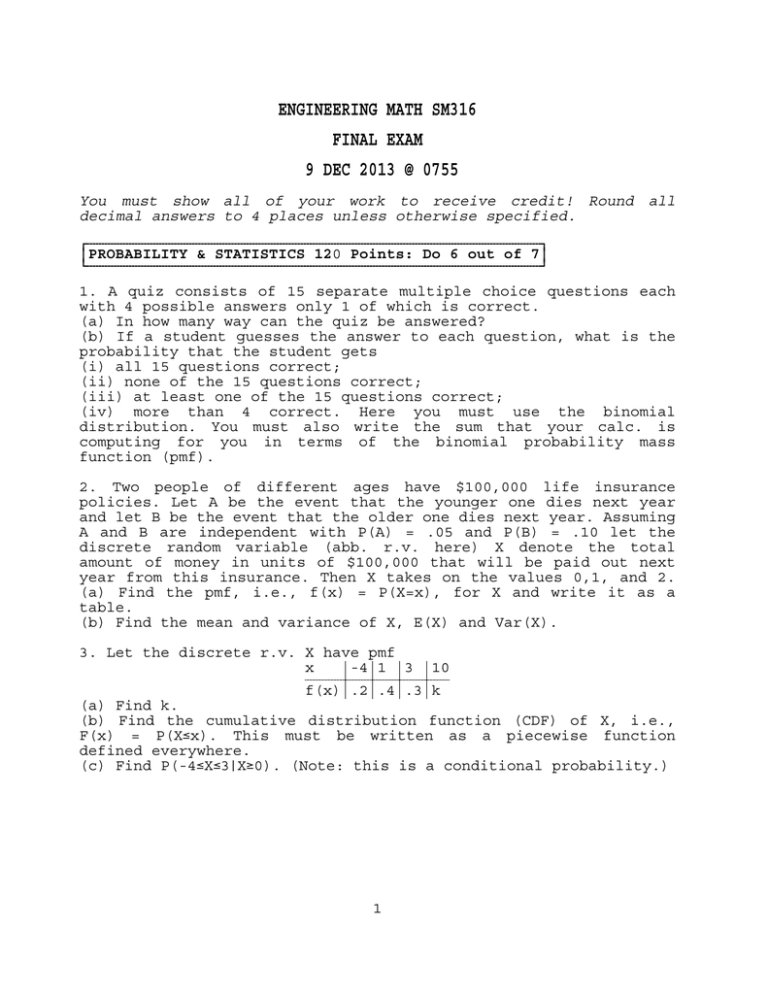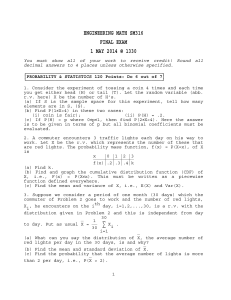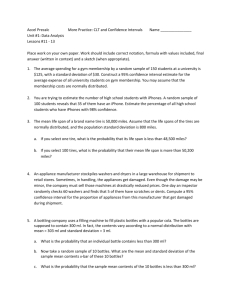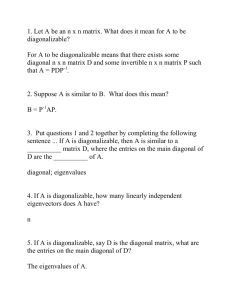ENGINEERING MATH SM316 FINAL EXAM 9 DEC 2013 @ 0755
advertisement

ENGINEERING MATH SM316
FINAL EXAM
9 DEC 2013 @ 0755
You must show all of your work to receive credit! Round all
decimal answers to 4 places unless otherwise specified.
q============================================================================================================================================================================================================================================================================================================e
PROBABILITY & STATISTICS 120 Points: Do 6 out of 7
2
2
z============================================================================================================================================================================================================================================================================================================c
1. A quiz consists of 15 separate multiple choice questions each
with 4 possible answers only 1 of which is correct.
(a) In how many way can the quiz be answered?
(b) If a student guesses the answer to each question, what is the
probability that the student gets
(i) all 15 questions correct;
(ii) none of the 15 questions correct;
(iii) at least one of the 15 questions correct;
(iv) more than 4 correct. Here you must use the binomial
distribution. You must also write the sum that your calc. is
computing for you in terms of the binomial probability mass
function (pmf).
2. Two people of different ages have $100,000 life insurance
policies. Let A be the event that the younger one dies next year
and let B be the event that the older one dies next year. Assuming
A and B are independent with P(A) = .05 and P(B) = .10 let the
discrete random variable (abb. r.v. here) X denote the total
amount of money in units of $100,000 that will be paid out next
year from this insurance. Then X takes on the values 0,1, and 2.
(a) Find the pmf, i.e., f(x) = P(X=x), for X and write it as a
table.
(b) Find the mean and variance of X, E(X) and Var(X).
3. Let the discrete r.v. X have pmf
x
-4 1 3 10
f(x) .2 .4 .3 k
(a) Find k.
(b) Find the cumulative distribution function (CDF) of X, i.e.,
F(x) = P(X<x). This must be written as a piecewise function
defined everywhere.
(c) Find P(-4<X<3|X>0). (Note: this is a conditional probability.)
1
1
1
1
-----------------------------------------------------------------------------------------------1
1
1
1
1
1
1
1
1
4. Let the continuous r.v. X have probability density function
(pdf) given by
(
2x
f(x) = {25 if 0 < x < 5.
0 otherwise
9
Compute the following:
(a) the CDF of X, F(x), given as above in problem 3. This must be
written as a piecewise function defined everywhere.
(b) P(1 < X < 6) in two (2) ways: (i) using the pdf; (ii) using
the CDF found in (a).
(c) Find the mean and variance of X, E(X) and Var(X).
2
2
------------
2
2
5. A rare disease exists with which only 1 out of 400 people is
infected. There is a test for it but the test is not infallible. A
correct positive result (i.e., given a patient has it, the test
says the person has it or is positive) has probability .95, while
a false positive result (patient does not have the disease) has
probability .01. (Note these are conditional probabilities.) If a
randomly selected individual has a positive test result, then what
is the probability that this person has the disease? Do all
computations to 5 decimal places.
(HINT: Make a TVD.)
6. (a) If X is a normal r.v. with mean m = 23 and standard
deviation s = 2.50, then
(i) write the pdf of X;
(ii) find a value of k to 5 decimal places such that P(X>k) =
.80000.
(b) Suppose that 5000 boxes are loaded onto an aircraft. All that
is known is that the weights of the boxes are identically
distributed independent r.v.’s, denoted Xi, i=1,2,...,5000, with
E(Xi) = 9.47 lbs and St.Dev(Xi) = 1.88lb. The aircraft will exceed
Maximum Allowable Takeoff Weight (MATW) if the combined weight
5000
s X
W =
t i
i=1
of the boxes exceeds 47650. Find the mean and standard deviation
of W. Tell what theorem says that W is approximately normal.
Finally find the probability that MATW is exceeded.
7. For each part of this problem, you must show all manual
computations. That means, for example, you must explicitly find
za/2 or ta/2 which ever is appropriate. There is no credit for
just writing down the confidence interval from you calculator.
A random sample of 22 soda bottles is selected from a production
line of several hundred thousands of such bottles. The population
mean, m, and population standard deviation, s, of soda bottle
content for all bottles are unknown. The sample, however, has a
2
------
mean value of x = 1.042 L. and a standard deviation of s = .071 L.
(a) Find a 90% two-sided confidence interval for the mean content,
m, of such soda bottles.
(b) Now, if it is known that the standard deviation of such
bottles is s = .0771, find again a 90% two-sided confidence
interval for the mean content of all such bottles.
(c) For part (b), tell how many such bottles must be sampled in
order to be 90% confident that the margin of error in using the
sample mean to approximate the true mean is less than or equal to
.010.
q==========================================================================================================================================================================================================================================e
Matrix Theory 80 points: Do 4 out of 5
2
2
z==========================================================================================================================================================================================================================================c
8. Determine whether each of the given sets of 3-dimensional
vectors is linearly independent or not. Show your reasoning. If
the set of vectors is linearly dependent, then find constants k2
and k3 such that V1 = k2V2 + k3V3.
(
)
(a) {V1,V2,V3}
9
0
(
2
2
(( )
4
={ 5 ,
1
9
9 0)
2
22
2
2
2
22
2
2
(( ) ( ) ( ))
( ) ( ))
3
1
(
)
2
3
1
0 , 1 } (b) {V1,V2,V3} ={ 1 , -1 ,
3 }
2
1
9
0
1
4
-2
9 0 9 00
99 0 9 0 9 00
2
2
2
2
2
22
2
2
2
2
2
2
2
22
22
2
2
2
2
22
2
2
2
2
2
2
22
2
2
2
2
22
2
2
2
2
2
2
1 3 0 0
1 -1 0 0 .
9. Let A = 0
0 1 2
0 0 4 3
9
0
(a) Find the rank of A.
(b) Tell from (a) without actually finding it whether or not A-1
exists.
(c) Determine (by hand) which of the following are eigenvectors
(abb. evec.’s here) for A:
( )
( )
( )
( )
( )
( )
1
0
1
3
0
1
-1
0
0
1
0
1
(i) 0
(ii) 1
(iii) 0 (iv) 0 (v) 0 (vi) 0
0
-1
1
0
0
0
9 0
9 0
9 0
9 0
9 0
9 0
(d) Find the eigenvalues (e-val.’s) by hand corresponding to each
of the evec.’s found in part (c) above.
2
2
2
2
2
2
2
2
2
2
2
2
2
2
2
2
2
2
2
2
2
2
2
2
2
2
2
2
2
2
2
2
2
2
2
2
2
2
2
2
2
2
2
2
2
2
2
2
2
2
2
2
2
2
2
2
2
2
2
2
2
2
2
2
2
2
2
2
2
2
10. For the following system, find all solutions, by hand, if
there are any. Here this must be done by row reducing the
augmented matrix to either ref or rref. This row reduction must be
done by hand showing each step. You then must also say whether
there is a unique solution, no solution, or infinitely many
solutions. If there are more than one solutions, then give 2
different specific solutions:
3
x + 3y - 2z = -7
4x + y + 3z = 5
2x - 5y + 7z = 19
(
)
2
2
1 2 2
11. Let B =
1 2 -1 . Find by hand the following:
-1 1 4
9
0
(a) the eval.’s of B;
(b) a maximal set of linearly independent evec.’s for B. Also tell
for each eval. its algebraic and its geometric multiplicity.
(c) Is B diagonalizable? Why or why not?
(d) If B is diagonalizable then give a matrix M such that D =
M-1BM, where D is a diagonal matrix. You must also write down
explicitly what matrix D is.
(Note: Here you may use your calc. to do det.’s and/or rref’s. But
if you just write down the eval.’s and evec.’s without any work
then you get no credit.)
2
2
2
2
12. (a) If C is the 3x3 coefficient matrix of the system given in
problem 10, tell whether or not C-1 exists. You do NOT have to
compute it, but you do have to say why it does exist or why it
does not exist. You can use your work from problem 10.
(b) Let the matrix A have characteristic polynomial
D(l) = (l-3)(l-2)(l+1)(l-4)(l+3).
Tell what the size of A must be.
(c) For the matrix A in (b), tell whether or not A is
diagonalizable and why.
(d) If the matrix A, from (b) above,
is diagonalizable then
matrices D and M can be constructed such that D = M-1AM where D is
a diagonal matrix. Tell what specific values would appear on the
main diagonal of D. Also tell what appears in M - here you can’t
give specific values because you don’t know the matrix A.
THE END
4







